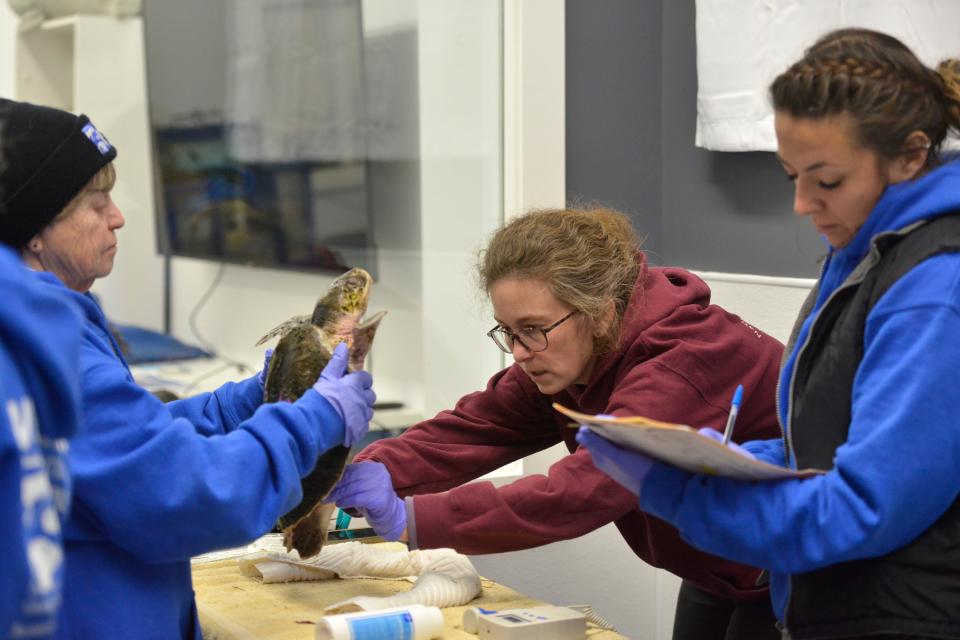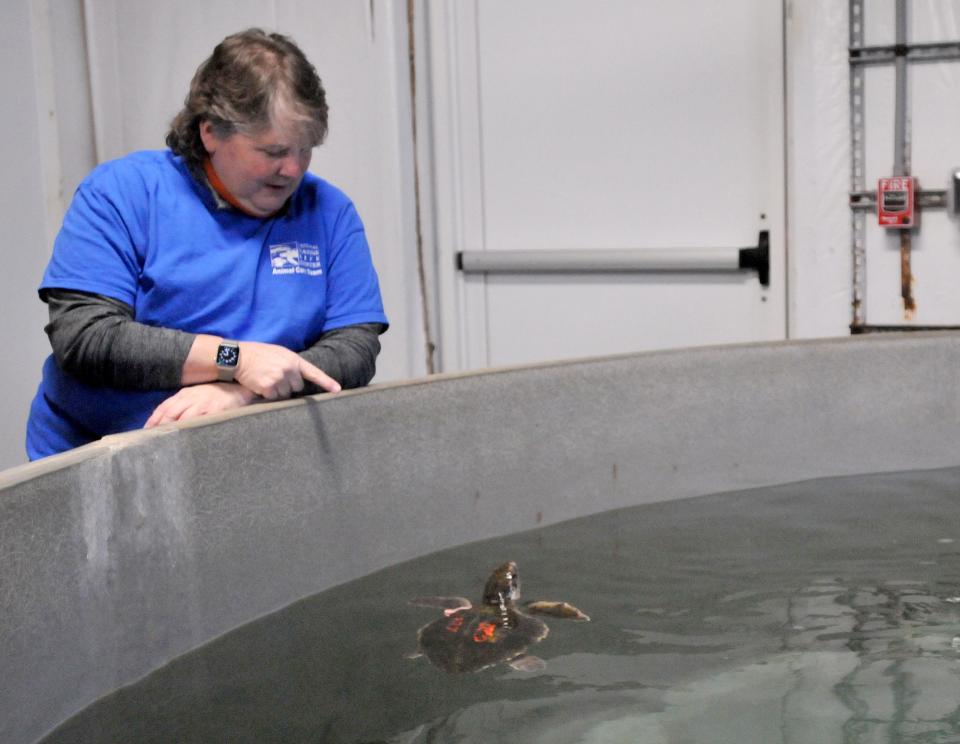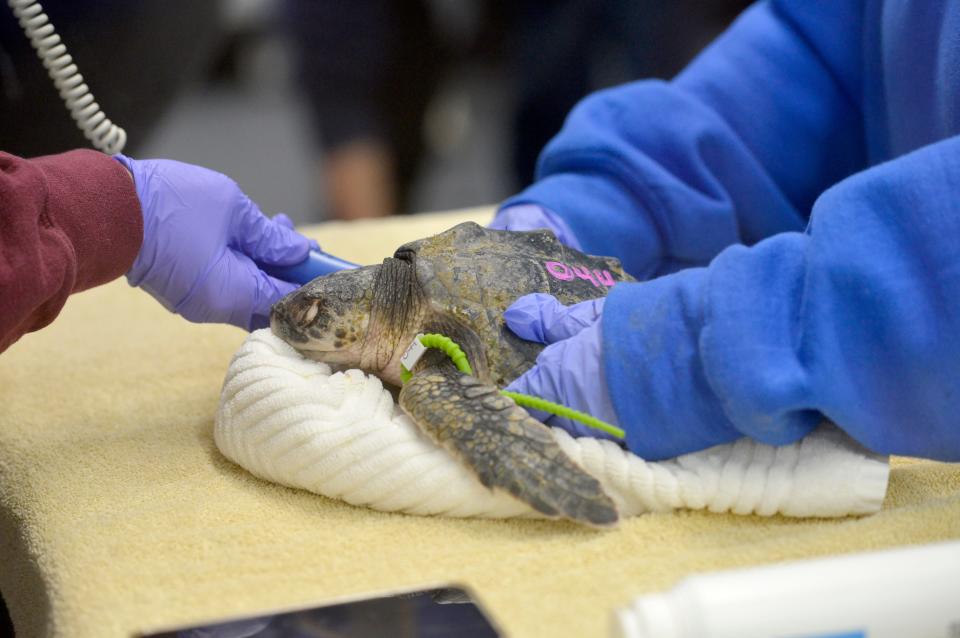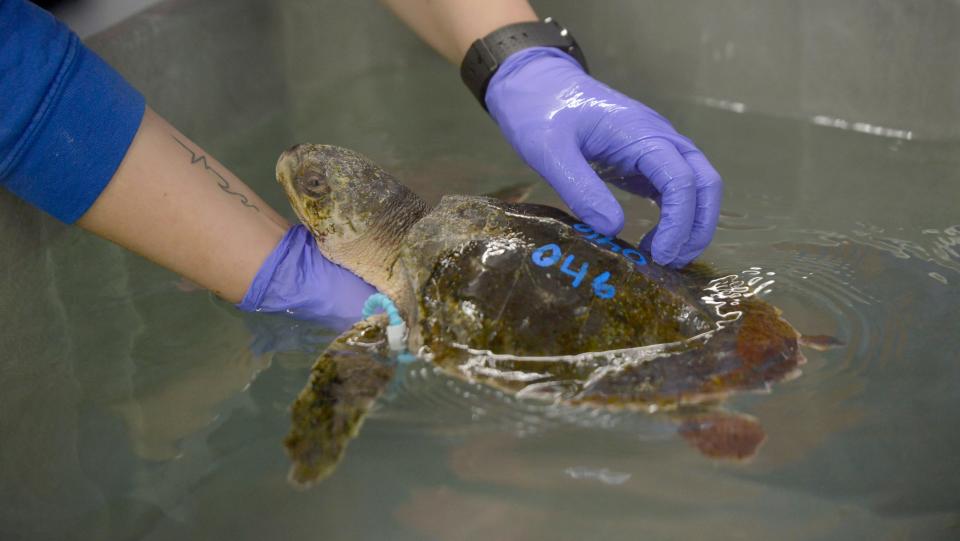'Turtles make me happy.' Warm-hearted heroes save cold-stunned sea turtles in Buzzards Bay
A greenish-gray turtle lay on a cart in the newly opened Sea Turtle Triage Suite at the National Marine Life Center in Buzzards Bay last week, where 20 severely cold-stunned turtles arrived during the day for revival, treatment and hopefully eventual release back to the ocean.
The little Kemp’s ridley sea turtle, an endangered species, looked unresponsive, eyes shuttered, flippers stiff and unmoving. But this lucky creature was in the hands of the Center’s rescue team, who are ready to step up.
Cape Cod is an East Coast stranding hot spot, due in part to the hook at its tip, which can trap sea creatures trying to leave Cape Cod Bay for warmer waters. An East Coast rescue network has been formed over the last decade, to restore life to sea turtles and seals that now strand on our beaches in early winter.

Aaron Gouveia, director of public relations at Mass Audubon’s Wellfleet Bay Wildlife Sanctuary, said that this season so far, volunteers have rescued 329 Kemp’s ridley turtles, eight loggerheads and 27 green sea turtles.
Buzzards Bay facility an important lifeline
The Marine Life Center, which first began accepting rescued turtles in 2004, has become an important lifeline in the stranding network, with its veterinary experts and rehab facilities offering a rapid response.
The newly arrived turtles look in rough shape, but they undergo a comprehensive rehab program that will involve physical exams by the Center’s veterinarians, medicine when indicated and — most important — time in the suite’s swim tank, where the water remains at 55 degrees. That's a revitalizing bath when you realize they’ve come from bay temperatures in the 40s.

Some arrive with a minimal two or three heartbeats a minute, according to Connie Merigo, president and executive director of the Center, and these first 15- to 20-minute submersions are critical in helping to restore life to stiff, unresponsive bodies.
“Paddling stimulates them to breathe,” she said, bringing vital oxygen back to heart and brain and to cold-stunned extremities.
One small turtle was lifeless until on-site vets administered a shot of epinephrine for a needed jump-start. Soon the creature was swimming, exercising flippers and raising a wrinkled head above the surface to blow bubbles.
Here’s what happens when a rescue team finds cold-stunned turtles in Cape Cod Bay
Wellfleet Bay Wildlife Sanctuary’s standby team of 150 volunteers rescue cold-stunned turtles from Cape Cod beaches after each high tide, from Halloween through early winter. The severely injured go directly to the New England Aquarium’s Animal Care Center in Quincy, while the rest are weighed and measured at Wellfleet and delivered to the Buzzards Bay facility, where each receives a flipper ID tag, with the number also painted on each turtle’s shell for easy identification. An all-important day one protocol of eat, swim and rest is initiated for each turtle by a dozen on-site volunteers.

Turtles surviving the first night will progress next door to the Center’s marine hospital and a larger swim tank, upped to a balmy 65 degrees. After night number two, they’ll move to the hospital’s 75-degree tank, gradually raising the turtles’ body temperatures.
Weeks of further rehab, nutrition and healing follow. Many turtles are transported to other East Coast rehab facilities, looking ahead to moving south and eventual ocean release after three to six months.
According to Merigo, the rehab protocols have changed and improved over time, and as many as 80% of these rescued turtles are likely to survive and return to the wild.
“Turtles make me happy,” said Merigo. “This has been my life for 35 years.”
Prior to joining the Buzzards Bay facility in 2021, she was a biologist at the New England Aquarium, and directed its Rescue and Rehabilitation Department.
Networked system streamlines a complicated rescue protocol

Crucial to the expanding rescue operation is a smooth “incident command system” that integrates the many scattered resources that must come together to make the program successful, similar to systems that may organize large-scale firefighting operations.
At the local level, Merigo added, the cooperative work involved in just one successful marine rescue cannot be underestimated. Well-organized treatment is critical, from rescue to rehab.
Can you see the rescued turtles in Buzzards Bay?
The facility’s Discovery Center, usually closed in winter, is offering special hours for visitors to see the newly finished Triage Suite and view resident turtles via live monitor. Hours are 10 a.m. to 4 p.m. Thursday through Sunday, Dec. 14-17. Admission is $8, but children are free. Proceeds help save sea turtles. More info can be found at the Center’s website at nmlc.org
The Center plans to open again for its regular summer season, from Memorial Day weekend through Labor Day.
Thanks to our subscribers, who help make this coverage possible. If you are not a subscriber, please consider supporting quality local journalism with a Cape Cod Times subscription. Here are our subscription plans.
This article originally appeared on Cape Cod Times: Meet the people rescuing frozen sea turtles from Cape Cod beaches

